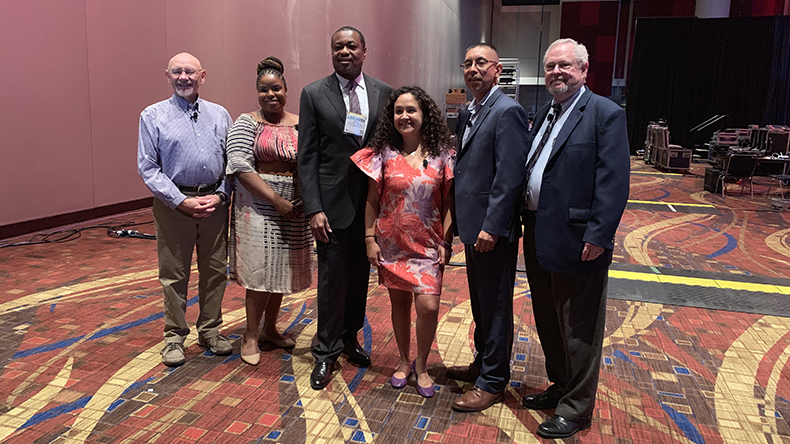“Gun Violence” is a Series of Problems, not a Singular Problem, says WJC Professor

Panelists who presented “Gun Violence: An Event on the Power of Community” at the APA Annual Convention in Chicago on August 10, 2019.
In 2017, the United States saw the highest rate of gun deaths in over two decades. That year, 39,773 people died from gunfire, which translates to approximately 12 deaths per 100,000 people. This figure includes homicides, suicides (which make up 60% of gun-related deaths), accidental death and deaths involving law enforcement.
“We don’t have a gun violence problem in the United States,” said Dr. Robert Kinscherff, PhD, JD, professor in the clinical psychology department. “We have gun violence problems that are distinguishable one from the other.” These problems, he said, include suicides, mass shootings, gun violence in an urban context, intimate partner violence, and other factors which need to be examined individually.
Kinscherff, who, in addition to his faculty appointment, also serves as associate vice president for community engagement at William James College and on a number of committees for the College and in the professional community, largely focuses his research on how to translate psychological findings into public health, public policy and legal strategies. He recently presented at the American Psychological Association’s (APA) 2019 annual convention in Chicago.
One of the main stage events, “Gun Violence: An Event on the Power of Community” brought together five experts to present on gun violence related to urban youth of color and participate in a discussion in light of the recent mass shootings in Dayton, Ohio and El Paso, Texas. Panelists seated with Kinscherff included: Dr. Arthur C. Evans Jr., CEO of the American Psychological Association; Dr. James Garbarino, author and professor at Loyola University in Chicago; Eddie Bocanegra, MSW, senior director of READi Chicago Project of Heartland Alliance; and Nelba Márquez-Greene, MA, LMFT, and founder and executive director of The Ana Grace Project, named for her daughter Ana Grace Márquez-Greene who was killed in the 2012 Newtown Elementary School Shooting. The event was moderated by Lolly Bowean, a journalist for the Chicago Tribune.
Kinscherff also gave a presentation discussing his research on violence risk assessment and management and other factors related to addressing gun violence in the United States, a video of which is available via the APA YouTube Channel.
“Psychologists can bring a lot to the table because we are researchers and practitioners in the area of human behavior,” said Kinscherff. “For public health strategies to be successful, they are almost always multidisciplinary strategies where the best thinking from a number of professions are brought together in order to figure out what level of intervention you want and what type of intervention you want.”
Kinscherff explained that training psychologists to adequately and comfortably conduct both suicide screenings and homicidality assessments could have an impact on reducing gun-related deaths. He also suggested increasing behavioral science research in psychology, sociology and anthropology to understand the culture, dynamics, and social learning around both legal and illegal firearms.
“Psychologists also have a role to play in combatting the stigma that’s associated with the common claim that mass shootings are not really a gun problem, they’re a mental illness problem,” he said.
The U.S. Department of Health & Human Services reports that not only are individuals living with a serious mental illness no more likely to commit violent acts than other individuals, they are over 10 times more likely to be victims. Research shows only between 3 and 5 percent of all violent acts can be attributed to people with serious mental illness.
“Where mental illness and guns do have a toxic interaction is the increased risk of suicide amongst persons with major mental illness when they have ready access to a firearm,” explained Kinscherff. Studies have shown that access to a firearm increases suicide risk for the United States population as a whole, with research indicating that having a gun in one’s home increases the likelihood that someone living there will commit suicide by a factor of between 2 and 10.
Looking at intersection of all gun violence problems in the United States, Kinscherff said, “The only common denominator is access to a firearm,” which is why gun violence must be addressed as multiple, unique issues.
A major issue that researchers in this arena face is inadequate funding, Kinscherff added. The United States federal government spends approximately $63 per life lost on gun violence research, according to a 2017 study. By comparison, motor vehicle research receives around $1,000 of federal funding per life lost, and robustly-funded HIV research receives over $180,000 per life lost. This discrepancy can be partly attributed to the 1996 Dickey Amendment, which, in addition to cutting funding, ensured that “none of the funds made available for injury prevention and control at the Centers for Disease Control and Prevention may be used to advocate or promote gun control.”
Kinscherff said, “Federal restrictions on funding for research into gun violence should be eliminated so that gun violence should be treated like any other public health problem has been.”
Dr. Robert Kinscherff was recently elected as a Fellow of Division 12 (Society of Clinical Psychology) of the American Psychological Association. He has a wealth of experience in child, adolescent and family forensic psychology, community violence and the law. Kinscherff previously served as Chair of the Gun Violence Prevention Task Force for the American Psychological Association, is a current member of the Expert Panel on Mass Violence of the National Council for Behavioral Health, and recently authored a chapter in the book Lessons from School Psychology.
- Tags:
- Research & Advocacy
Topics/Tags
Follow William James College
Media Contact
- Katie O'Hare
- Senior Director of Marketing
- katie_ohare@williamjames.edu
- 617-564-9389
